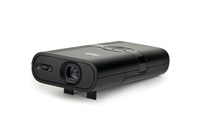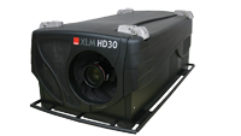

Technology Showcase: Pico Projectors
Oct 8, 2009 2:54 PM,
By Jay Ankeney
New products lay the groundwork for a potentially dynamic market.
3M MPro120
When pico projector technology was first unveiled just a couple of years ago, many wise wags predicted that pico projectors would never be bright enough or have enough battery life to be practical. Now companies around the world are making these mighty mites a reality—both as standalone devices and embedded in mobile phones, PDAs, portable video players, and portable digital devices not yet unleashed.
You mgiht imagine a herd of rampaging teenagers each with his own projection pod slinging images on any surface anywhere, challenging each other with light saber duels of their favorite pet images. And yes, pico projectors will be a boon to traveling salesmen, teachers, and even grandparents who want to share photos of their kids. However, beyond those obvious manifestations, the ability to produce a display that is much larger than the device that created it will also bring a slew of unexpected consequences—and opportunities.
Related Links

Ever since pico projectors hit the retail market in mid-2008, awareness has grown about the promise of these tiny handheld, pocket-sized devices. The interest in pico (pronounced “pee-co”) projectors reflects the world’s increasingly mobile workforce…

Price erosion is hardly new to the front-projection industry and neither is the less-than-$1,000 level. We’ve seen a variety of projector classes and types–first SVGA business units, then XGA models, then 720p video projectors, etc….

Real-world Projector Considerations
For my recent home-theater build, I decided to take the plunge into the front-projection market. …
Almost everyone who gets a chance to experience a pico projector is intrigued by its implications, but predictions of its impact vary widely. In the Aug. 19 issue of Display Daily, published by Insight Media , Senior Analyst Matt Brennesholtz reported that one optimistic component manufacturer predicted sales of 100 million pico projector units per year by 2015. Brennesholtz said other forecasters put the figure closer to 17 million in 2012, and that the market research firm iSuppli pegs the embedded pico projector sales at 3 million in 2013. For 2009 sales, Brennesholtz wrote, “Our expectation is a total of about 350K pico projectors will be sold this year.”
One reason this is such a potentially dynamic market is that there are currently three major competing technologies for the display engines, or imaging chips, and each offers its own benefits. In June 2007, Microvision announced it had signed an agreement with Motorola to embed Microvision’s PicoP display engine into Motorola mobile devices. Microvision’s PicoP projection module uses RGB laser beams reflected off a single mirror etched in silicon that can move in all axes to scan an image onto a screen. Although Motorola never released its own pico projector-equipped product, just last September Microvision announced the commercial introduction of the world’s first laser-based pico projector called Show WX.
At InfoComm 2008, Optoma introduced its first DLP-based pico handheld projector, the PK 101. It uses incredibly tiny micromirror arrays from Texas Instruments called the DLP Pico chipset that get their illumination from an LED light source. In September 2009, Optoma brought out its successor, the PK102, boasting 4GB of internal memory.
The first-generation DLP Pico chipset won the Silver Award at the Society of Information Display’s Display of the Year in May. Earlier this year, Texas Instruments brought out its second-generation chipset (also called the DLP Pico), increasing both power and light efficiencies while shrinking the chip even further.
There is also a third major player in the pico projector sweepstakes. In January 2008, at the Consumer Electronics Show (CES) in Las Vegas, 3M unveiled its own MPro110, a mobile pico projector that won the Grand Award in the gadget category of the Popular Science’s Best of What’s New 2008 Awards. At this year’s CES, 3M brought out its second-generation manifestation, the MPro120, based on 3M’s new MM200 light engine that uses an advanced liquid crystal on silicon (LCoS) electronic imager and is illuminated with multicolored light emitting diodes (LEDs).
Even this does not exhaust the field, with several other companies pursuing their own schemes for getting big pictures out of miniscule imaging devices. But all of the manufacturers of these little light engines are hoping that other companies around the world will be conjuring up new applications for their technology. Some are still on the drawing board, and many are available initially only in foreign markets.
Technology Showcase: Pico Projectors
Oct 8, 2009 2:54 PM,
By Jay Ankeney
New products lay the groundwork for a potentially dynamic market.
3M MPro120
Here is a look at some of the most intriguing pico projector products available today. As you will see, something this small is destined to be something very big.
3M is proclaiming its new MPro120 pico projector as a second-generation unit because it’s the first with its new MM200 projection engine. The MPro120 is capable of beaming out a VGA image (640×480) with 100 percent color gamut and includes two integrated, 0.5W stereo loudspeakers that transform the MPro120 into a self-contained presentation device for entertainment or business applications. The MPro120 can project 8in. to 50in. still or moving images stored on a video capable device such as a MP3 player or laptop computer using LCoS technology and an LED light source with predicted 20,000-hour life. The MPro120 provides users with a battery life of 2 hours to 4 hours (depending on brightness setting), which is enough to watch a full-length film. In full-brightness mode, 3M’s MPro120 achieves a brightness of 12 lumens. Featuring an integrated flip stand, tripod, and variety of input cables, the MPro120 is ready to use right out of the box with a wide range of today’s most popular video output gadgets.
AAXA Technologies claims its AAXA P2 pico projector is the brightest pico projector on the market. Designed for the professional user, the AAXA P2 micro projector employs an ultra-efficient optical engine design, new LCoS chip, and high-power LED to achieve a 33 lumens output at 800×600 resolution, which means when used in darker environments, the AAXA P2 can produce spectacular images up to 80in. Professional features include a direct VGA connector supporting up to 1280×720 resolution for laptop connection, an infrared remote control, dual 0.5W stereo loudspeakers, and onboard gamma correction. The battery life of the AAXA P2 is rated at 60 minutes (standard battery), with optional super-thin 35-minute and 180-minute batteries available. Additional accessories allow the AAXA P2 to connect to Apple iPhone/iPod, Microsoft Zune, Sony PlayStation Portable (PSP), and a wide range of cell phones from Nokia, LG, Samsung, and HTC.
The PocketCinema V10 Plus portable projector with media recorder from Aiptek lets you project a 50in. image on any surface using a 3M’s MM100 light engine. The PocketCinema V10 Plus comes complete with an integrated media player, 4GB of built-in memory, and support for up to 32GB SDHC cards. The V10 Plus also allows you to record video from any video source onto its internal hard drive so you don’t have to contend with file conversions or uploads. Using 3M’s LCoS technology in its imaging system, Aiptek’s V10 Plus has a white LED light source that lasts up to 10,000 hours and produces 10 lumens at VGA (640×480) resolution. It also comes with a remote control.
Aiptek is also offering its PocketCinema V10 standalone handheld pocket projector, capable of throwing a 42in. image from more than 5ft. The PocketCinema V10 standalone pico projector can handle various video formats including MPEG-4 (Non DIVX-AVI, .ASF, .MP4) and H.264 through ArcSoft Media Converter conversion. It comes with a USB cable, among other connectors.
At June’s Display Week, Light Blue Optics (LBO) announced its holographic laser projection technology that can create WVGA video and still images at 10 lumens or more depending on the content shown. LBO’s proprietary imaging technology has an ultrawide throw angle and the ability to correct for optical aberrations using software. These features enable LBO’s miniature projection systems to switch from conventional front projection onto a wall to a novel table-down projection mode where the device is placed on a table and the content is projected down onto the surface in front of it. The user can then control the projector and interact with multimedia content simply by touching the projected image. LBO announced its first product is scheduled for release to OEM customers in Q4 ’09.
Technology Showcase: Pico Projectors
Oct 8, 2009 2:54 PM,
By Jay Ankeney
New products lay the groundwork for a potentially dynamic market.

Microvision Show WX
In September, Microvision announced the commercial introduction of the world’s first laser-based pico projector, the Show WX, based on Microvision’s proprietary PicoP display engine technology. Show WX is a simple plug-and-play pico projector capable of throwing an image from 12in. to 150in., depending on ambient light. Users can plug the Show WX into their portable media players, mobile phones, notebooks, and other portable mobile media devices with TV-out or VGA functionality and share a big screen experience with friends, family, or business associates. Show WX is no larger than an iPhone, is completely battery-operated, and can project a full-color, WVGA (848×480), DVD-quality image with vivid colors and enhanced contrast.

Nikon CoolPix S1000pj
One of the most eagerly anticipated pico projector products is Nikon’s CoolPix S1000pj compact digital camera, which features the world’s first in-camera projector based on Nikon’s own LCoS imaging engine using a 1W LED light source capable of 10 lumens. As a result, the CoolPix S1000pj transforms photo sharing into a multimedia experience, or what Nikon calls “your personal theater on the go.” The CoolPix S1000pj can present a 40in. image from the camera’s 12.1-megapixel imager. With the camera’s unique slideshow function, it can play back pictures with music, effects, and creative transitions for up to an hour’s enjoyment.

Optoma PK102
Adding new connectivity and memory features to its original PK101 pico projector, Optoma has introduced the PK102, calling it the world’s smallest and most advanced battery-powered DLP projector. The PK102 weighs just 4.4oz. and produces a 2000:1 contrast ratio and enough brightness for users to project images up to 60in. With 4GB of internal memory, enough to hold 6,000 pictures or 8 hours of video, the new PK102 can project its images directly from the internal storage or from USB memory keys and other external memory card readers. It can also connect to an iPod, smartphone, digital camera, or other device with video output and show videos, photos, or presentations playing on these devices.
Samsung Telecommunications America (Samsung Mobile) started this year by bringing out what it calls a “new mobile phone accessory,” the MBP200 pico projector. The MBP200 can connect to mobile phones and laptops, and it allows users to project content with up to a 50in. viewing screen. In addition, users can easily transfer files and project content independent of an attached source via the MBP200’s microSD card slot. This HVGA (480×320) pico projector can accommodate screen sizes from an 8.5×11 standard sheet of paper to a large 50in. screen. For added convenience, the MBP200 comes with a small screen holder with a telescoping pole hidden inside, which can instantly turn a standard sheet of paper into a screen to view movies, document files, or pictures. The MBP200 was named the CES Innovations 2009 Design and Engineering Best of Innovations in the wireless handset accessories category.
At April’s Hong Kong Electronics Fair, Chinese company SCT Optronics showed off its VideoLit projector, an 8-to-10 lumens standalone pico projector using RGB LEDs rated at 20,000 hours as its light source and boasting a USB connector for power. SCT Optronics claims the VideoLit pico projector with its VGA 640×480 pixel resolution and 50/60Hz PAL and NTSC compatibility is the ideal companion to multimedia devices such as iPod, phone, digital camera, DV, or gaming console since its projected screen sizes vary from 5in. to 73.5in.

WowWee Technologies Cinemin Swivel
Last August, Using Syndiant introduced the SYL2030 display panel for pico projectors, using the company’s own patented smart panel VueG8 based on LCoS technology as the imaging source, asserting it is the world’s smallest WVGA (854×480 pixels) microdisplay at only 6mm tall with a pixel array diagonal of 0.21in. and a 5.4-micron pixel pitch. The SYL2030 is intended for the embedded pico projector market by enabling very thin (less than 7mm) optical modules that can fit into a large number of handsets and other handheld devices.
According to its maker, WowWee Technologies, the new Cinemin Swivel pico projector harnesses the same Texas Instruments’ DLP technology commonly found in high-definition TVs. Just starting to ship in October from major retailers nationwide including Brookstone and Amazon.com, the Cinemin Swivel features a unique adjustable 90-degree hinge intended for projecting onto a ceiling, which, among other applications, is handy for watching movies while lying in bed. It also sports full volume control for its 0.5W mono audio loudspeaker, an audio jack for a headset or loudspeakers, and a 2-hour battery life. WowWee’s Cinemin Swivel puts out 8 lumens, HVGA (480×320) resolution, and has a reverse feature that allows back-projection.










